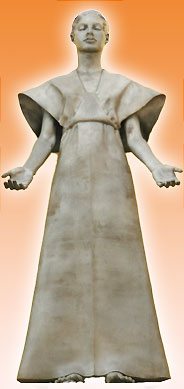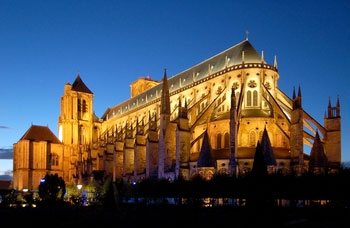The topic on which I have been asked to speak today is “The Cult of Ugliness in America.” I do not intend to speak of every possible example of ugliness in our society. That would be exhausting if not thoroughly discouraging. We already live cheek-by-jowl in an incredibly ugly culture; we cannot escape it. So if there is any purpose to this talk, it is to keep you aware of the very real danger that you might miss the ugliness entirely and never catch on to the real destruction that this ugliness is working in your very souls.
Now, what could I possibly mean by the word “ugly”? Is it too glib to say that if beauty can be defined as that which when seen pleases, then the ugly is that which when seen displeases? Why does it displease? Is there some definable element that tells us that an ugly piece is ugly? Is there an obvious line or shape or combination of lines and shapes that screams, “ugly!”
What can we make of the modern phenomenon whereby what is considered ugly nonetheless pleases — or what would be considered beautiful in another era or society is deemed by ours to be ugly?
For example, when I say that you live cheek-by-jowl with this ugliness, I mean to say that in coming to and going from this hall you are surrounded by miles and miles of unyielding ugliness: McDonalds and Burger Kings sandwiched between Amocos and tenements. You do not mistake that for beauty, but it is so ubiquitous that you may no longer recognize it as specifically ugly.

You may never even make a mental note of the ugliness of all the malls with their false fronts and even falser interiors, or of the condominiums that are just as empty and sterile on the inside as they are on the outside. That’s just how everything looks now.
And, of course, that’s just for starters, for there is likewise in our world a spiritual ugliness no less all-pervasive than and somehow related to the visual ugliness all about us.
You will turn on your car radio only to hear of some new school shooting, and you won’t even be sure if this is the eighth or ninth such massacre in as many months. You will, however, be able to form a mental image of the alleged perpetrators, for you have seen the look and the fashions on your own block and maybe even within your own families: the chopped, colored hair, the mutilations, the tattoos, the rings in the nostrils and eyebrows, the baggy clothes, the backward baseball caps, the surly looks and the sullen grunts. You’ve even heard their music — God have mercy on us; we’ve all heard their music.
Then, of course, when you finally reach home, you will turn on the television news to hear of our scientific culture’s progress in the harvesting and sale of babies’ body parts. You will see news bytes of the political candidates trying to outdo each other in their dedication to killing babies.

Los Angeles, the Cathedral
of Our Lady of the Angels.
Perhaps then, after supper, you will turn the channel to a show where you are treated to hour after hour of actors and actresses spewing vile lines in ever more tawdry productions. Could television programming be any less accurately described than by saying it consists of ugly, mean people doing ugly, mean things to each other? Indeed, the ugliness is so universal, so part and parcel of our lives, that it hardly registers in our minds anymore. And having drunk fully of this awful cup, you go to bed.
Now, you might think that at least on Sunday you could be rescued from all of this visual and spiritual ugliness by going to church; but ugliness is there, too, for chances are that your church has already been despoiled by modern Catholic barbarians who haven’t even the artistic sense of the Unitarians who sit on your towns’ historic preservation boards.
The modernists will already have removed the tabernacle to a closet and the crucifix to the rectory basement. They will have torn up the sanctuary and torn down the shrines; and they will have done their expensive best to ruin whatever vision of spiritual loveliness the first parishioners and the first architect possessed. But, again, you are so used to it by now that what they have done to your church in the name of reform barely registers anymore in your minds — at least not until you have to confront what they have also done to the Mass — ever-perky, ever-childish, ever-changing, ever-boring, ever-therapeutic, until you are no longer sure who should be more embarrassed, you for still being there or the liturgists who invented it all.
No, the cult of ugliness is so pervasive, so all around us, in every nook and cranny of our lives, that we stand the risk at every moment of missing it, of no longer being able to see it or even be repelled by it.
What is Beauty?
Our talk will be divided into three parts: We shall first try to understand what has always been traditionally understood by the use of the word “beautiful” by most people in most eras, and in fact, how traditional Catholic philosophy was able to sort out that traditional understanding of beauty into an actual set of principles, the violation of which would yield ugliness.
Secondly, we shall try to situate these understandings of beauty and ugliness in the context of culture — or cult or faith — to see how beauty and ugliness flow naturally into the world from the content or emptiness of the soul.
Thirdly, we will make some personal resolutions, which we hope would take us a long way towards the destruction of this Cult of the Ugly.
Nature, the Matrix for Beauty
Ask any child who is drawing something what he is trying to do and he will tell you that he is trying to recreate something that he saw in nature, be it an apple, or the sun, or a tree, or a house. And, invariably, the measure of the success of the drawing for that child is how closely the drawing resembles nature.
Accuracy according to nature was always the standard of reference for artists and societies, for all high civilizations from the Egyptians and Greeks to the Romans and Europeans. Each culture’s succeeding generations of artists tried to improve upon, or at least remember, the techniques, lessons, and discoveries of the previous generations, always seeking a greater beauty of lines, more solid figures, and truer perspectives.
It was generally accepted that there was infinitely more to a face than just that face — something else between the proportions of nose, eyes, cheekbones, jawbones, lips, and mouth — and this, of course, would be “beauty.”

beauty as that which when
seen pleases.
If, therefore, we are to understand anything about the “Cult of Ugliness,” we must first understand what beauty is. Its definition is basic enough. According to the great saint-philosopher of the Middle Ages, Thomas Aquinas, beauty is that which when seen pleases.* No more, no less. If colors and forms and shapes and compositions would please beggars and kings all at the same time, then that would be considered “beautiful.”
But why does it please? What would make the heart delight in that which the eye saw? Well, Saint Thomas said that if something gives us pleasure then there is always somehow present in the thing which gives pleasure something that is “good,” and the good always attracts us, always pleases us.
Now the good, which a person sees and senses in some beautiful thing, is its “form.” That is, it’s wholeness, its proportions. If such a thing is complete, right, and balanced, it is “good,” and what happens is that we are attracted to that “form” because we sense that there is in the object the same kind of form within us. We see and sense in the form of the beautiful object a “good.” And the good in it echoes the good in us — or at least the good that should be in us. We are fascinated and attracted by that sameness. It delights us and we want to remain in its presence.
Did you ever watch babies and see how they are totally taken in by other babies, how they react to those other little creatures that are so like them? How they stare at other babies, recognize the similarities, and even reach out to touch their faces?
The form of a beautiful object is considered beautiful because it is whole and proportionate, as we would sense ourselves to be whole and proportionate. We delight in the beauty of our own being. There is a resemblance between that which is in us and that which is in the beautiful object. And we are pleased.
But that is not all there is to the story. There is one more element present without which we cannot achieve all this pleasant recognition. Just as the eyes of the body need actual light to see anything, so too the eyes of the soul need a similar light which Saint Thomas calls claritas — clarity — a spark of light, so to speak, that glances off the beautiful object and actually comes from the beautiful object. It is the very same spark of being which comes from the Being of God. The very Being of God is present in the being of the object, and God’s beautiful Being is therefore revealed in the form and proportions and clarity of the object. Precisely because a beautiful thing is a reflection of the Beauty of God, we are naturally drawn and attracted to it as we would be drawn and attracted to God in our desire for union with Him.
The beauty of God is somehow mysteriously reflected in the beauty of being — first in nature, then in trees, sunsets, in faces and forms and figures; and then it is reflected in art — in drawings and paintings and sculptures and even in architecture (and, somehow, even more mysteriously, in music.)
The closer those artistic forms conform to nature, the closer they conform to the supernatural, and the more accurately do they reflect the truth, the beauty, and the goodness of God.
Beauty is Objective
We have been made to believe for generations now that beauty is in the eye of the beholder, that it is all a matter of taste and culture, opinion and upbringing, that there is no true objective beauty out there that can be used as a universal standard. It all comes from one’s mind and what one likes. So, if you think a horribly skewed, out-of-shape series of smears and stains is beautiful, then, for you, it is beautiful.
Well, I stand here today to say, along with thirty thousand years of human instinct and two thousand years of Catholic tradition, that beauty is not in the eye of the beholder. Beauty resides in the beautiful thing itself. It will either have proportion, wholeness, integrity, and clarity in itself and be from God, or it will not have those qualities and will be displeasing to the discerning soul and will therefore be ugly.
You see, just as theological modernism denies the objective reality of the supernatural, saying that all dogma, all revelation, is just your experience and, therefore, the truth is what you think is the truth, so too, artistic modernism tries to convince us that whatever anyone thinks is beautiful is beautiful for that person.
Indeed, today no one is allowed to say that anything is ugly, for to call something ugly hints at the possibility of an actual real standard of reference by which some things can be beautiful and some things not beautiful. This hints at the possibility of a claim to objective truth, which is certainly not allowed in today’s society because that would hint at a God.
We are cowed into a moral and cultural silence before the modern proclamation that a squat, misshapen, mis-proportioned figure is somehow beautiful — and even perhaps more artistic than the figure that God first created. How could it be said that that which seemed so ugly to us was still somehow beautiful to them? Well, they say it still, but now we know that this attitude is simply a modern intellectual conceit, by which their higher appreciation of art makes them superior to those not in on the game.
For the same reason, no one today is allowed to say that anything is wrong, to say that something is evil, or to say that something is immoral. If there is nothing that is in and of itself “true,” then neither is there something that is in and of itself good or bad — neither beautiful nor ugly.
Indeed, when you walk into some modern monstrosity of a church and your instinctive reaction is, “My God, this is ugly,” you are right. It probably is ugly. And you have no less an authority than Thomas Aquinas to back you up.

You incur no moral or aesthetic fault if weird angles and blank concrete walls in a church make you feel uneasy and uncomfortable. There is no sin in seeing some hideous deformation of Christ on the cross or some monstrous representation of Mary and saying that it is hideous, that it is monstrous. Nor is there virtue in trying to think that, somehow, it is all really beautiful and that there must be something wrong with you. You need no longer feel forced into a corner bleating, “Well I guess I don’t know much about art.” It may simply mean that your good human and Catholic instincts are still intact and that they have, somehow, survived this ugly, ugly society.
Now you might be thinking: “My goodness, the world is falling apart and he’s talking about drawings. More than a million babies a year are being sucked out of the wombs of their mothers and he wants to discuss pretty pictures. Seventy per-cent of Catholics don’t even go to church anymore and he’s giving us lessons on the philosophy of art. If we wanted Sister Wendy we could have turned on PBS.”
This goes much deeper than aesthetic philosophy. It refers to the way we think about and deal with life itself — all of life, all of nature, all of being. All human activity is meant by means of beauty to provide us with an access to God, Who is All-Beautiful.
To Produce Beauty One Must Possess Beauty

It takes virtue to do virtuous things. Indeed, it takes virtue to even recognize virtue or to recognize its opposite. And if you possess this virtue, this grace — this natural penchant for the supernatural, this healthy sense of beauty, you will see, know, feel, and do things of which the rest are simply incapable.
The same goes for the sense of beauty. Unless beauty first resides within, it will never be exemplified without in any part of our society. Nor will it even be recognized.
That remnant sense of beauty — in our minds and hearts — by which we can still recognize the ugliness out there, either in ugly buildings or ugly philosophy or ugly lives, must be cherished and guarded as our last weapon in the struggle with No-God.
But how is it that the rest of our world has become so relentlessly ugly at every level? We seem to wallow in it. Well, perhaps it is clear by now that our society, no longer possessing virtue — theological or practical — no longer possessing grace or faith or even the dimmest notions of God, has embraced emptiness. Having forsaken the true God, having blinded ourselves to His “claritas,” His spark, His light, we dwell in ugliness, darkness, and confusion.
We do not see or accomplish virtuous or beautiful things without, because there is no longer virtue or beauty within. A society that does not believe in God or super nature or even truth — let alone beauty — will do only ugly things.
Tragically enough, our world does not even know that it is ugly. We have already said that beauty is that which when seen pleases, and therefore we would know that the ugly would be that which when seen displeases. But look at our society, where it has become the macabre, the strange, the twisted, and the deformed that please. Where the most popular piece of cinema in years — number one for weeks — is a movie about a cannibal. It is the evil and ugly that now delights.
Well, welcome to the “Brave New World,” where that which in another era would have been called bad is now called good, and that which was once considered ugly is now considered beautiful.
The Cult of Ugliness Targets God Himself and Our Perception of Him
This discussion is hardly about pretty pictures. It is about the ever-ancient assault on His beauty — the original affront to His very existence and to the nature and the life that He created. The cult of ugliness in our land is no less than Satan’s rage against God. It is no less than the gleaming spear-point of the culture of death.
Moreover, the cult of ugliness is so utterly pervasive and thorough in its celebration of the fruitless, the sterile, the weird, and the ugly that it pushes to the margins all other faiths — above all the True Faith.
The subliminal message in every confused and misshapen piece of modern architecture, art, music, or drama is that there is no God. The subliminal message in every deliberate mutilation of natural forms, in every tribute to physical and personal perversion, is that there is no God. The subliminal message in every celebration of the weird and deathly is that there is no God. This subliminal message is as surely the “Illuminated Gospel of Death” as any culture could have ever proclaimed, and by virtue of its omni-presence in every aspect of modern life, we are constantly encouraged to accept this gospel.
Sadly, even much of the clerical caste, whose task would certainly be understood to include fostering the cult of the beautiful as part of its proclamation of the Gospel of Life — and whom we certainly imagine would defend us from the ugly allurements of the No-God, is often too dense to see what is going on, and itself has surrendered in so many ways to the Cult of Ugliness.
This is demonstrated every time we walk into a church to see some splayfooted, goggle-eyed Christ on a cross or some rude, crude cement Madonna. The poor priest thought he was simply purchasing a nice piece of contemporary art for his flock. In all innocence and ignorance he assumed he was simply obtaining some fresh interpretation of traditional religious themes and was never conscious that what he was looking at and what he was filling the eyes of his flock with was actually the human form exploded, exploited, and degraded — reduced to its individual and impotent parts and slapped together again in a unsettling imbalance — all for the purpose of revealing and teaching the modern loathing of living forms, the modern loathing of a Creator.
No, the poor priest never thought he was doing that. I don’t think he thought it through at all. I don’t think he ever questioned the spiritual source of such strange shapes, or ever wondered from what terrible fonts such new forms sprang.
Perhaps he never suspected the existence of a Cult of the Ugly. Perhaps he just assumed that it was all a matter of taste, and that his taste, like that of his flock, was simply old-fashioned and ready for a little jarring now and then. Well, we have all been jarred.
 Look at some of our newest churches and cathedrals. Many of them are stunning and awesome — no, not for their homage to tradition and the Catholic sense of beauty. They are stunning and awesome in their utter inhumanity, their complete lack of scale, their thorough and total sterility, and their horrifying proportions. There is not an angle that could please nor an arch that could comfort. Not a piece of molding that could hold us in its shadow. Not even a little statue before which we could light a slender taper. Like the gaping mouth of the pagan, child-sacrificing furnaces of Moloch, some of our new churches will consume their people in holocausts of visual horror. I venture to say that one or two of these ecclesial “worship spaces” are some of the most terrifying pieces of architecture to have ever been accomplished by and for modern Catholics. I shudder at what harm this ugliness may accomplish in the souls of those who try to pray there. They are the clearest possible examples of the nihilism, the emptiness and nothingness, of which modernity constantly speaks — the relentless message that there is nothing out there — neither nature, nor beauty, nor God. And will we surprise ourselves to discover one day, by means of such architecture, that there is nothing left in our souls either?
Look at some of our newest churches and cathedrals. Many of them are stunning and awesome — no, not for their homage to tradition and the Catholic sense of beauty. They are stunning and awesome in their utter inhumanity, their complete lack of scale, their thorough and total sterility, and their horrifying proportions. There is not an angle that could please nor an arch that could comfort. Not a piece of molding that could hold us in its shadow. Not even a little statue before which we could light a slender taper. Like the gaping mouth of the pagan, child-sacrificing furnaces of Moloch, some of our new churches will consume their people in holocausts of visual horror. I venture to say that one or two of these ecclesial “worship spaces” are some of the most terrifying pieces of architecture to have ever been accomplished by and for modern Catholics. I shudder at what harm this ugliness may accomplish in the souls of those who try to pray there. They are the clearest possible examples of the nihilism, the emptiness and nothingness, of which modernity constantly speaks — the relentless message that there is nothing out there — neither nature, nor beauty, nor God. And will we surprise ourselves to discover one day, by means of such architecture, that there is nothing left in our souls either?
Oh, what a series of ironic tragedies. We Catholics, thinking that we were opening the windows to dialogue with modernity, never had a clue that we were being used. Having spoken for so long in the language and in the forms of the modern world, we thought that we could put a Christian interpretation to the philosophy of the atheistic Enlightenment. We thought that now they would love us and come to our side. But we have found ourselves saying and meaning things we did not want to say or mean. And we do not even know how to unsay those things anymore. There it is for all the world to see — our newly acquired evangelical impotence and spiritual paralysis so clearly shown in the confusion of our renovated churches, the foolishness of our experimental liturgies, and the emptiness of our new cathedrals. Why indeed would anyone be attracted to the beauty of God, if this is what it looks like? And we will find one day that we ourselves are growing distant from God because His fascinating beauty is no longer to be found even within our own buildings.
What to Do?
So what do we do? What is the answer? Should we spend our remaining energies and spin our wheels trying to convince, to change, to convert our culture? And we really do sometimes think that, don’t we? We think that if everyone would see that one beautiful statue, or that one beautiful church, or would hear that one perfect argument or one beautiful Mass chant, then they would all be converted.
But how many converts came streaming into the Church after hearing the Gregorian chant recording from Spain? Sure it sold millions, but most, I’m sure, regarded it as little more than mood music to accompany them on the treadmill. The moderns had no idea about what these monks were singing — and Latin was not the problem.
How many of us thought, twenty-five years ago, that if we could just show everyone photos of the developing fetus, the pro-life cause would triumph conclusively? No one cared; and now we find ourselves fighting the battle against infanticide.
Well, is it all over? Do we throw our hands up in total discouragement? Do we resign ourselves to the physical ugliness and spiritual vacuum of our age? Do we surrender to the No-God of our era, place ourselves on the dung-heap of modernity and, like Job, wait for a merciful death?
No, I don’t think we have to. First among all our tasks is that we remain converted and committed to the God of our Fathers, the God of all beauty and all being. And then, naturally and unself-consciously, we will share among ourselves the beauty that we have interiorly experienced.
True Catholic culture has been left to us to create anew and afresh — with precious little reference either to our modern society or even to the clerics panting so faithfully after modernity. We ignore it and them and, taking a tip from the purveyors of the cult of ugliness, we proceed to fill our minds, our hearts, our families, our children, and our world with as much beauty as possible that by dint of the quantity and quality of our efforts there will be no room for that which is inhuman, ungodly, or ugly.
If this sounds like a clarion call back to the catacombs — that we withdraw from our modern culture — then so be it. Yes, that too is heresy in our contemporary Church culture where we are constantly encouraged to engage and embrace the modern world. But in doing so — as we have seen over these last tragic decades, we stand to gain nothing and lose all in such a poisonous encounter.
But where are those catacombs? Where are those refuges from the human and spiritual horrors of our “Brave New World”? They are in your very homes, your front rooms and bedrooms, your home schools and private academies. That is where the true culture of the New Millennium will take shape, for, undistracted by the pomps and pleasures, the flashy arrogances and fleshy superficialities of the ugly world around us, mothers and fathers can form and mold and guide their children with unadulterated faith and inculcate into their souls every form and example of beauty.
And in isolating and insulating your children from the moral squalor about them, you are only strengthening them in their eventual confrontation with it. Fill the walls of your homes with beautiful art, fill the ears of your family with beautiful music, fill the souls of your children with beautiful stories, and there will be no room left for the insipid, the warped, the ugly, and the faithless. If you can make of your family a little Church, you will not have to be engaging constantly in rear-guard action to counteract the toxins of the media and schools or that of your children’s strange new friends down the block. They will not be forced to unlearn at home the lessons they have just learned outside.
Your families will come to know and appreciate that there is only one thing about which to be busy, around which to revolve, only one thing to cultivate, and that is their souls, the beautiful gift from God. This realization will then help them do beautiful things, create beautiful things, and appreciate all the beautiful things that issue forth from beautiful grace-filled souls.
And if we do this, then, little by little, as modernity continues to die — as surely it must, for is not death its very theme? — it will be replaced by life, in fact a new Culture of Life whose healthy hallmark will be the celebration of the beauty of God in the beauty of the life around us.
Oh, indeed there is a Cult of Ugliness in our society, but it is not our cult and we will have nothing to do with it.
This talk on “The Cult of Ugliness in America” was given by Father Anthony J. Brankin on March 14, 2001 to a full auditorium in the amenable atmoshpere of the Washington Bureau of The American Society for the Defense of Tradition, Family and Property (TFP) in McLean, Virginia.
